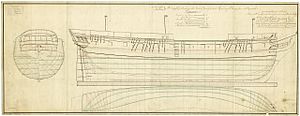HMS Boreas (1806) facts for kids

HMS Boreas
|
|
Quick facts for kids History |
|
|---|---|
| Name | HMS Boreas |
| Ordered | 30 January 1805 |
| Builder | Stone, Great Yarmouth |
| Laid down | June 1805 |
| Launched | 2 June 1806 |
| Completed | 16 November 1806 at Chatham Dockyard |
| Fate | Wrecked 28 November 1807 |
| General characteristics | |
| Class and type | 22-gun Laurel-class sixth-rate post ship |
| Tons burthen | 52626⁄94 (bm) |
| Length | 118 ft 0 in (36.0 m) (overall) |
| Beam | 31 ft 7+3⁄4 in (9.6 m) |
| Depth of hold | 10 ft 3 in (3.12 m) |
| Propulsion | Sails |
| Sail plan | Full-rigged ship |
| Complement | 155 |
| Armament |
|
HMS Boreas was a British warship launched in 1806. It was a "post ship," which was a type of smaller warship with 22 guns. Sadly, the Boreas was wrecked off the coast of Guernsey in the Channel Islands on November 28, 1807. Most of its crew of 154 men were lost in the accident.
What HMS Boreas Did
The Royal Navy officially put the Boreas into service under the command of Captain Robert Scott. This meant the ship was ready for duty.
On October 2, 1807, the Boreas chased a French privateer (a private ship allowed to attack enemy ships) called Victoire. After a four-hour chase, the Boreas captured the Victoire. This French ship had 28 men and small weapons.
The Victoire had sailed from Morlaix the day before. It had already captured an American merchant ship. The Boreas was able to get this American ship back. A few days later, on October 8, 1807, the Boreas and another British warship, Brilliant, captured two Danish ships, the St Hans and the Montreal.
The Ship's Final Voyage
The Boreas left Saint Peter Port in Guernsey to help a small boat called a pilot cutter. The cutter was in trouble because of bad weather. The Boreas took the cutter in tow (pulled it behind) and started sailing back around Guernsey.
However, the Boreas hit a dangerous rock called Requiers. An experienced pilot was on board and told the ship to turn around quickly. But the officer in charge of the watch (the group of crew members on duty) refused to do anything without the captain's direct order. This confusion led to the ship being lost.
After trying to save the Boreas without success, Captain Scott ordered the crew to leave the ship. He sent some men ahead in boats to land at Hanois Point. But the strong waves and some crew members leaving the boats meant the boats could not go back to rescue everyone else. The Boreas eventually sank, with only its rigging (the ropes and sails) still visible above the water.
The next morning, boats sent by Admiral James Saumarez rescued 30 men. Admiral Saumarez was the commander of the Royal Navy's Channel Islands fleet and was from Guernsey. In total, 120 people drowned, including Captain Scott. Some of the survivors left without permission.
After a ship is lost, a special hearing called a court martial is usually held. In this case, the captain, officers, and crew were praised for their good behavior during the disaster.
A Lighthouse and a Museum
The sinking of the Boreas made people realize how important it was to build a lighthouse in that area. Because of this, the Les Hanois Lighthouse was built on Guernsey between 1860 and 1862.
Today, Fort Grey on Guernsey is a shipwreck museum. You can find one of the cannons from the Boreas there. The cannon points towards the reef where the ship sank, reminding visitors of the tragic event.

